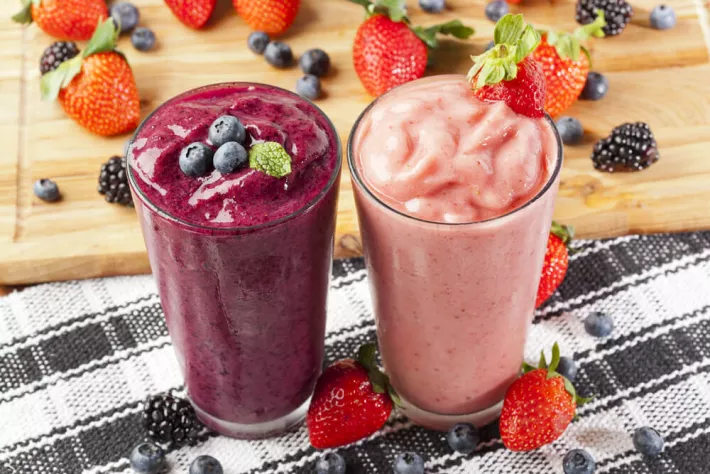Nutrition Diva listener Jeffrey writes:
“I feel like I get plenty of fiber, but I recently heard that blending fruits in a smoothie destroys the insoluble fiber. Am I defeating my health goals by blending the fruit?”
This is a question I get a lot–which is not surprising when you consider the popularity of smoothies and juicing. But I get an equal number of emails from listeners who have heard that blending fruits and vegetables ruptures the cell walls and makes the nutrients more absorbable. So which is it? Does liquifying your fruits and vegetables make them more nutritious or less?
To tell you the truth, although these two assertions about smoothies are widespread on the internet, it is tough to find a whole lot of factual backup. But there’s an old saying that “You don’t have to know everything as long as you know where to look.” For help in answering your questions, I turned to one of the smartest guys I know: Dr. Lee Falin, host of the fantastic Everyday Einstein podcast, who pointed me toward some great resources. Thanks for the assist, Lee!
Does Blending Destroy Fiber?
Fiber is not a single nutrient but a whole class of related compounds with similar functions in the body. Even the classification of fiber as either “soluble” or “insoluble” is an oversimplification. Like sugars and starches, fiber is made up of carbohydrate molecules. Unlike sugars and starches, however, our bodies cannot dissolve the bonds between the individual carbohydrates in fiber, so these carbohydrates don’t get absorbed in the digestive system. That’s what we mean when we say that fiber is “indigestible.”
Blending, however, does chop fiber into smaller pieces. How this affects its activity in the body depends on what kind of fiber we’re talking about. An article Lee dug up for me in The Journal of Food Science notes that grinding up wheat bran reduces its ability to hold water, which presumably decreases its effectiveness in promoting regularity. In fact, one study found that supplementing the diet with very finely ground wheat bran actually caused constipation!
Oat bran on the other hand soaks up more water when you reduce the particle size. There’s also some research suggesting that grinding up vegetable fiber into smaller pieces makes it more effective in reducing cholesterol.
So, I don’t know that we can say that blending “destroys” fiber. But we can certainly conclude that blending “changes” fiber in foods and how they affect the body. Based on my brief tour through the literature, I think I would avoid putting wheat bran in my smoothie. Flax seed, on the other hand, is really only useful as a source of fiber if you grind it (or chew it up really well). Coarsely ground flax appears to be slightly more effective than finely ground flax…so don’t overdo it.
Does Blending or Juicing Make Nutrients More Available?
But what about this idea that blending fruits and vegetables releases their nutrients? Although I wondered whether cells would be far too tiny to be affected by a blender, Lee assures me that scientists use blenders to break up cell walls all the time. (They also use heat, enzymes, acids, and other methods to rough up the little guys.)
And, indeed, there is some research showing that certain nutrients in fruits and vegetables may be better absorbed from juice than from whole foods. This may be, in part, because the nutrients have been “released” from their cells. But with juice you’ve also removed most of the fiber. As helpful as fiber can be in cleaning out the digestive tract, it also traps some nutrients along with the debris. In my opinion, this is usually worth the trade-off.
Assuming that your diet contains a good amount and variety of fruits and vegetables (and for those worrying about the cell wall integrity of their vegetables and particle size of their fiber–I’m guessing this is a safe assumption), squeezing every last microgram of beta-carotene out of every carrot doesn’t really add that much additional benefit (although it can turn your skin orange).
Does Blending Foods Make them Better or Worse For You?
I’m afraid there’s no simple answer. Blending or juicing foods can make certain nutrients more absorbable. It may decrease the effectiveness of some fibers but increase the effectiveness of others. Honestly, I think this falls into the (rather large) category of things that probably aren’t worth worrying about. If you enjoy smoothies or fresh juice, feel free to include them in the rotation. They can be a good source of nutrition. And for tips on how to get the most out of them, please see my previous episodes on How to Make the Perfect Smoothie and Juicing for Health and Nutrition
But I wouldn’t suggest liquifying all of your fruits and vegetables. Eating solid foods provides other benefits, such as increased satiation and satiety and better blood sugar control. The debate over whole fruits vs. juice reminds me a bit of the debate over raw food diets. While raw foods have some nutritional advantages, cooking foods provides other benefits. For best results, include both in your diet!
What Do You Think?
I’d love to hear your thoughts on this or any other nutrition topic. Post them below or on the Nutrition Diva Facebook page. And please sign up for my free weekly newsletter for more tips, recipes, and answers to listener questions.




